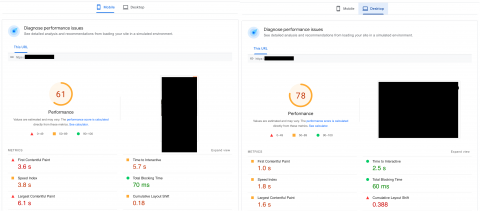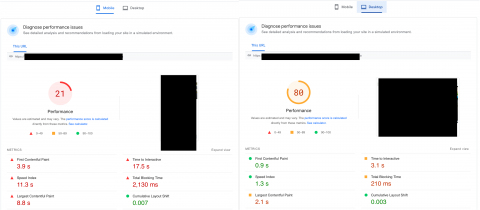How valuable is a sign spinner without a leasing specialist to greet incoming prospects? If your answer is "not very useful," then stick around. This article can help save thousands of wasted digital advertising dollars.
A successful digital advertising strategy has a two-pronged focus:
1. Optimizing the ad campaign
2. Optimizing the landing page(s) or website
You can create the best digital ad campaign with high-performing keywords, robust targeting, and engaging copy. You can have the best conversion tracking and reporting money can buy. Still, if you don't also have a fast and flexible website designed with digital advertising in mind, you are wasting considerable ad dollars. I'm not speaking of some high-concept, theoretical waste here— this is a quantifiable loss, and it's common in Multifamily.
Optimizing your website for digital advertising may seem like an obvious strategy. Still, I can attest, after 15 years of developing digital ad campaigns for Multifamily, almost no one in the business focuses on what happens after someone clicks on an ad. While perhaps well intended, the few who focus on this aspect are often misguided in their strategy.
Slow website load speeds are eating away at your advertising budgets
You may be familiar with the term bounce rate. But for those who aren't, here's a simple definition— a bounce occurs when someone visits your website, then leaves before interacting with the site in some way. Bounce rate is the percentage of users who land on your page, then "bounces." There are countless studies on bounce rate and what causes it. A common conclusion— load speed or the time it takes for your website to be useable to a visitor, is the number one cause of a high bounce rate. Visitors are clicking on your ad, landing on your website, then moving on to the next apartment community before you ever get a chance to sell them on your property. With digital advertising, you often pay per click regardless of whether the visitor waits for your website to load or not. If your website is taking too long to load, and the visitor bounces before gathering more information, you've wasted the money you spent to get them there.
Based on this recent study, websites with a load speed under two seconds have a 9% bounce rate, on average. Websites with five-second load speeds, just three seconds longer, have a bounce rate of almost 40%. Let's do some math. Suppose your property is spending $1,000 on digital advertising per month, and your property website has a load speed of five seconds. That's $400 tossed into the digital trash can each month. With an increase of another two seconds in load speed, seven seconds in total, the waste increases to over half of your one thousand dollar budget. All this waste is happening before we even tap into other aspects of website optimization, like the ability to make custom landing pages or improved copywriting.
Say you're a regional manager who oversees 15 properties. You are likely wasting anywhere between $72,000 — $100,000 of your advertising budget each year. A company with a sixty property portfolio and an average ad budget of just $750/m could be wasting as much as $220,000 a year. To put it another way, it costs nearly a quarter-million dollars each year to maintain slow-loading websites. And again, that's just talking about bounce rate loss due to load speed. That figure is likely higher if you currently have a property website where it is impossible or time-consuming to create custom landing pages for niche campaigns.
Bad websites are an expense your company cannot afford
Now, you may think I am exaggerating the issue for effect — perhaps some smaller property management companies with fewer resources have slow websites, but not the big guys, right? Unfortunately, the major players in Multifamily are often the biggest offenders.
Load Speed Test Results: Multifamily Websites 2022
Yesterday I conducted a page load speed test for the home pages of four apartment communities owned or managed by the biggest names in Multifamily. These property websites have paid for Google Ads in the past twelve months. Here are the results:
(Note: I blacked out the property names to protect the innocent ☺️)
Test Property A: 5.8 seconds until First Contentful Paint & 21.6 seconds until interactive

Test Property B: 4.3 seconds until First Contentful Paint & 24 seconds until interactive

Test Property C: 3.6 seconds until First Contentful Paint & 5.7 seconds until interactive

Test Property D: 3.9 seconds until First Contentful Paint & 17.5 seconds until interactive

How much advertising money do you think these properties waste each year? How many visitors are willing to wait 21 seconds before being able to fully use the website? My guess is these communities are overspending on digital advertising because half of their money is wasted on bounce rate. And these properties were plucked out randomly. This is an industry-wide issue.
Below are the results for my company's website. Granted, an apartment website has different needs than a marketing agency website, but there is no reason why you can't have a site just as fast.
2.6 seconds until First Contentful Paint and 2.6 seconds until interactive
How did we get here?
No company sets out to have slow websites but, it happens. The problem goes far beyond Multifamily. Some estimates are as high as $6.8 billion lost annually due to slow websites. Most management teams I've worked with are very invested in website design. The challenge is the way we prioritize our needs, or, in many cases, our wants when it's time to design a new site for the properties.
The road to underperforming websites is often paved with flashy designs. Large management companies can sometimes get caught up in the hype of the latest and greatest design trends, adding too many needless third-party integrations and cool-looking but very heavy design features. I call these types of websites flash-and-trash. What's worse, the home pages to these websites get so bogged down with pop-ups, instant messaging icons, and auto-playing videos that most prospects have no idea what they should do when they get there.
The most common mistake for Multifamily website design is chasing the integration dragon. Perhaps it makes sense on paper to allow the company that provides your accounting software to design your marketing website for the sake of integration, but it comes at a hefty price. Whatever money you saved by automatically updating your rates and availability, you lose tenfold in sluggish websites and ridged designs.
For two hundred and twenty grand per year, you could design a blazingly fast, state-of-the-art website that outperforms anything in the Multifamily space and still have money left over to hire a dedicated web admin to keep all your websites updated. Heck, you could do it all for a fraction of that cost. If you were determined to spend it all, you'd have a website template as a good or better than Airbnb, which you could then launch for each one of your 60 properties and build upon the platform for years to come. And that comes from just fixing load speed. Imagine the revenue you could generate if you optimized your website for your digital ad strategy using the dozens of other largely ignored yet proven methods?
Like a sign spinner with an empty leasing office, a digital advertising campaign with a slow website means you could be wasting thousands of dollars of your marketing budget each year. Thanks for sticking around. I hope this helped.


